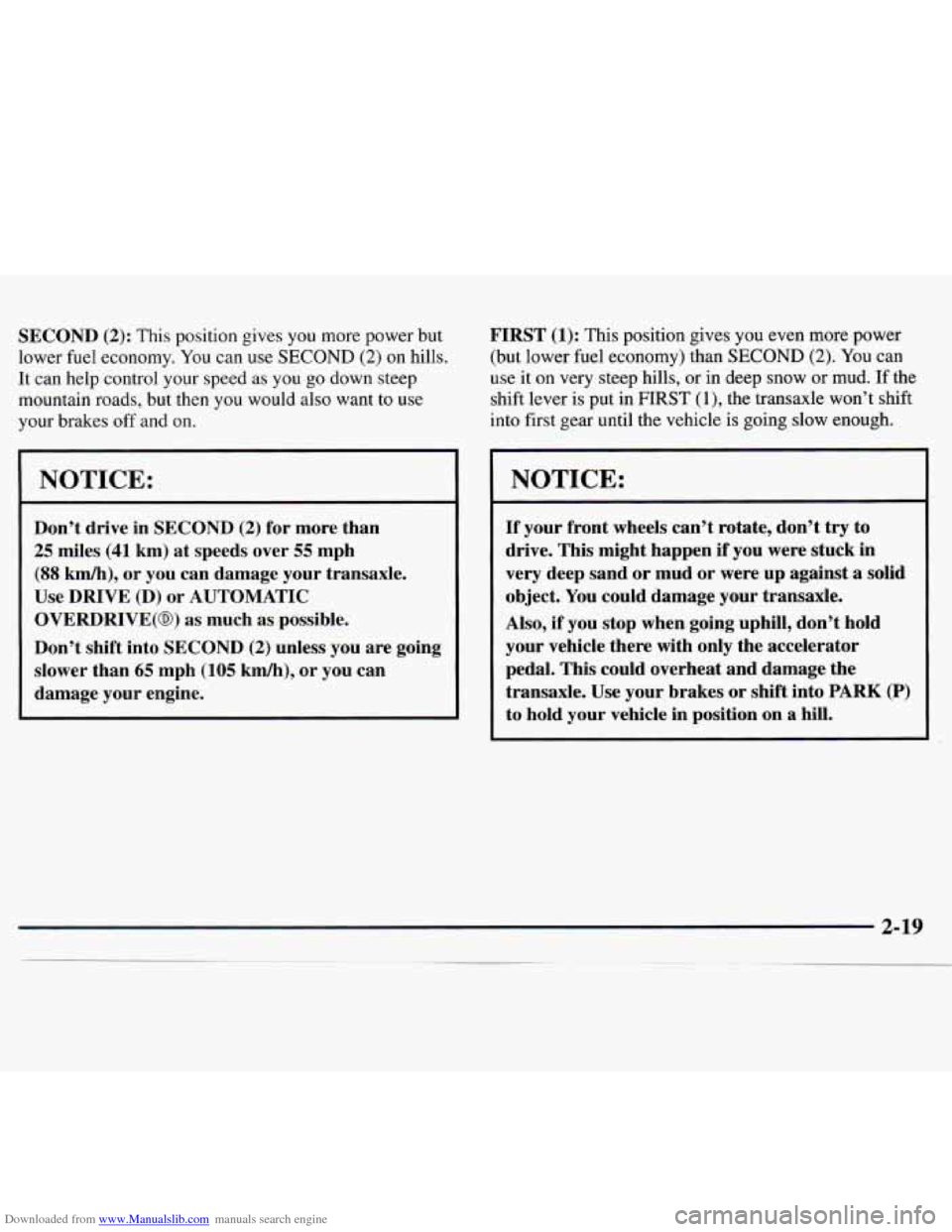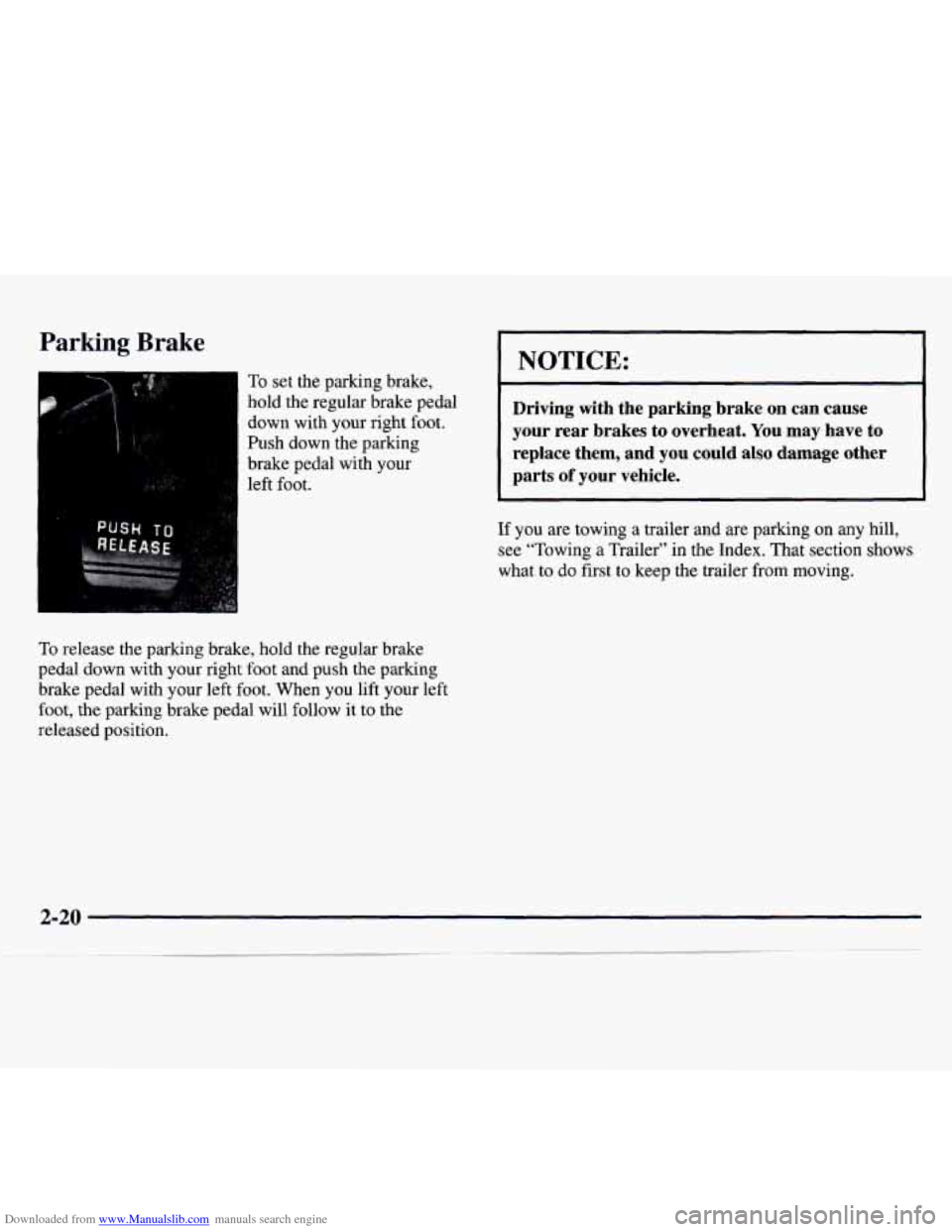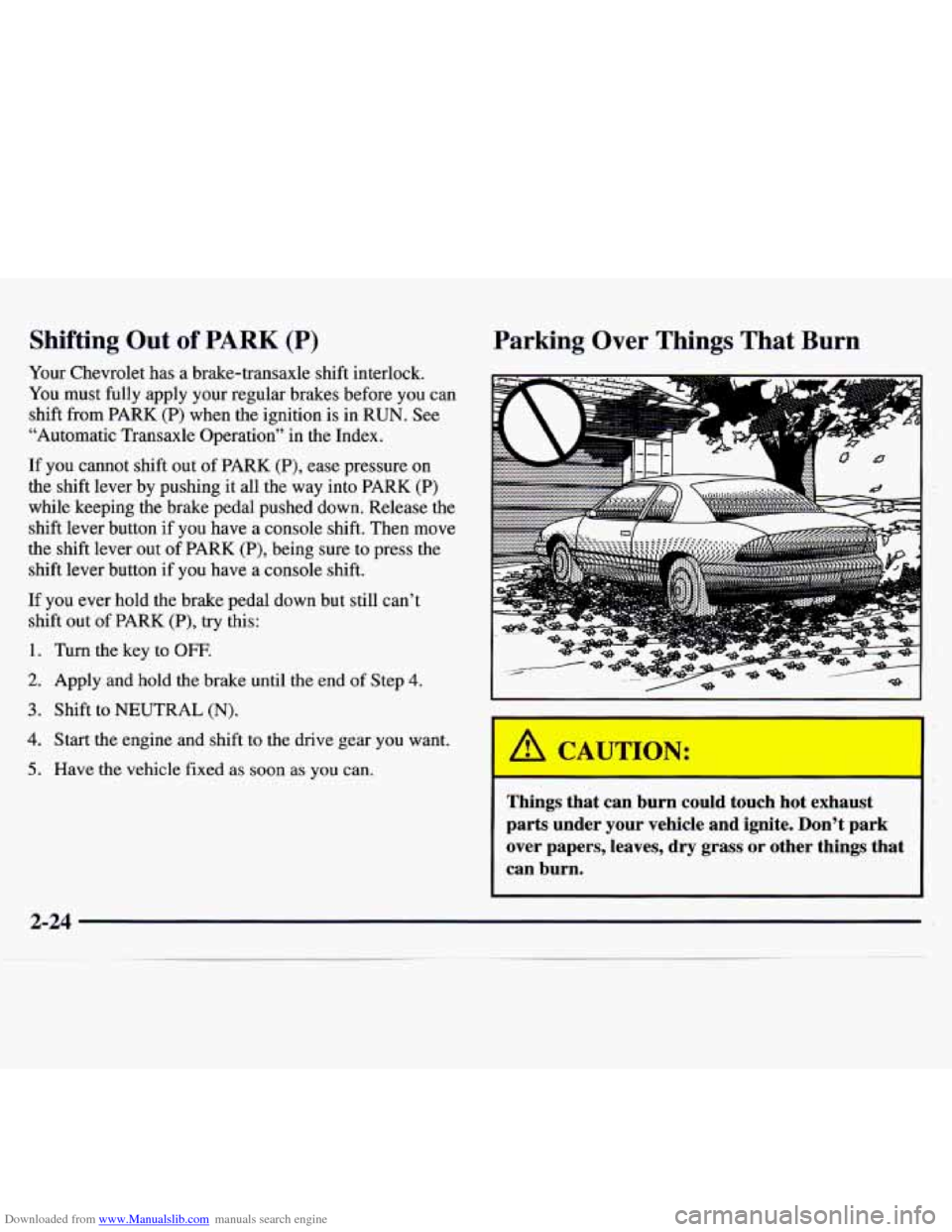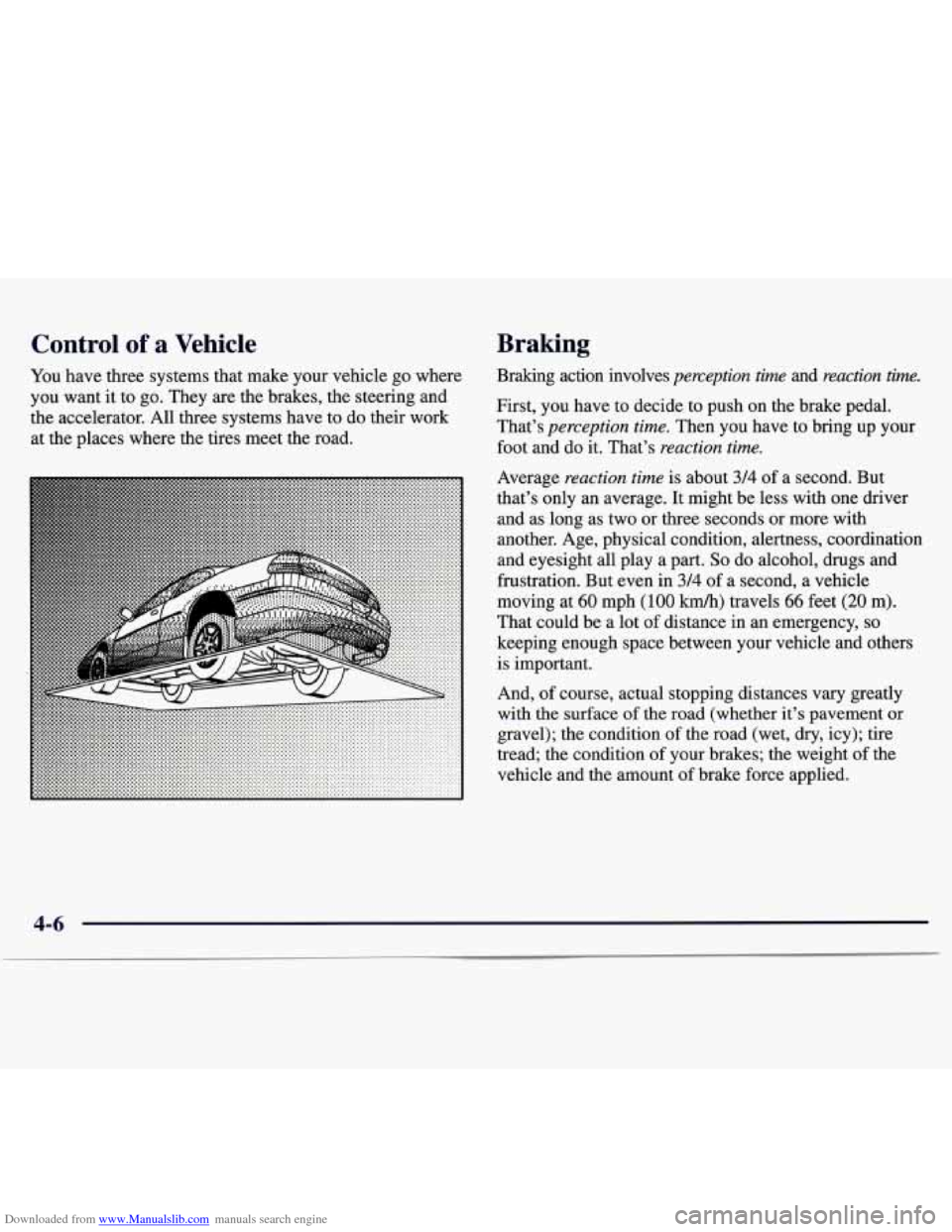1997 CHEVROLET MONTE CARLO brakes
[x] Cancel search: brakesPage 9 of 358

Downloaded from www.Manualslib.com manuals search engine Vehicle Symbols
These are some of the symbols you may find on your vehicle.
These symbols
are important
for you and
your passengers
whenever your
vehicle is
driven: These symbols
have
to do
with
your lamps: These symbols
are on some of
your
controls: These symbols
are used
on
warning and
indicator lights: Here
are some
other symbols
you may see: I For example,
' these symbols
are used
on an
original battery:
WINDSHIELD
WIPER
POSSIBLE
A
CAUTION
INJURY FUSE
COOLANT
TEMP
-
PROTECT EYES BY
SHIELDING
Q
SIGNALS e e
TURN
DOOR LOCK
UNLOCK
LIGHTER
CHARGING
1-1
BATTERY
SYSTEM
CAUSTIC HORN
)cr WINDSHIELD DEFROSTER BRAKE
(0)
FASTEN
SEAT
BELTS
BURNS
SPEAKER
b
COOLANT
a AVOID
SPARKS
OR
FLAMES
I
WINDOW
DEFOGGER
RUNNING
' 0
DAYTIME -
LAMPS * '
POWER
WINDOW ENGINE OIL
e,
PRESSURE FUEL B SPARK OR ,\I/,
COULD FLAME
EXPLODE BA'ITERY FOG LAMPS # 0
VENTILATING
FAN ANTI-LOCK
(@)
BRAKES
Page 76 of 358

Downloaded from www.Manualslib.com manuals search engine Make sure the shift lever is fully in PARK (P) before
starting the engine. Your Chevrolet has a brake-transaxle
shift interlock. You must fully apply your regular brakes
before you can
shift from PARK (P) when the ignition is
in
RUN. If you cannot shift out of PARK (P), ease
pressure on the
shift lever by pushing it all the way into
PARK (P) while keeping the brake pedal pushed down.
Release the
shift lever button if you have a console shift.
Then move the shift lever out of PARK (P), being sure to
press the
shift lever button if you have a console shift.
See “Shifting Out of PARK (P)” in the Index.
REVERSE (R): Use this gear to back up.
NOTICE:
Shifting to REVERSE (R) while your vehicle is
moving forward could damage your transaxle.
Shift to REVERSE (R) only after your vehicle
is stopped.
To rock your vehicle back and forth to get out of snow,
ice or sand without damaging your transaxle,
see
“Stuck: In Sand, Mud, Ice or Snow” in the Index.
NEUTRAL (N): In this position, your engine
doesn’t connect with the wheels.
To restart when you’re
already moving, use NEUTRAL
(N) only. Also, use
NEUTRAL (N) when your vehicle is being towed.
Shifting out of PARK (P) or NEUTRAL (N) while
your engine
is “racing” (running at high speed) is
dangerous. Unless your foot
is firmly on the
brake pedal,
your vehicle could move very
rapidly. You could lose control and hit people or
objects. Don’t shift out of
PARK (P) or
NEUTRAL
(N) while your engine is racing.
NOTICE:
Damage to your transaxle caused by shifting out
of
PARK (P) or NEUTRAL (N) with the engine
racing isn’t covered
by your warranty.
2-17
Page 78 of 358

Downloaded from www.Manualslib.com manuals search engine SECOND (2): This position gives you more power but
lower fuel economy. You can
use SECOND (2) on hills.
It can help control your speed as you go down steep
mountain roads, but then you would also want to
use
your brakes off and on.
1 NOTICE:
Don’t drive in SECOND (2) for more than
25 miles (41 km) at speeds over 55 mph
(88 km/h), or you can damage your transaxle.
OVERDRIVE(@) as much as possible.
Don’t shift into SECOND
(2) unless you are going
slower than
65 mph (105 kmh), or you can
damage your engine.
~
I Use DRIVE (D) or AUTOMATIC FIRST
(1): This
position gives you even more power
(but lower fuel economy) than
SECOND (2). You can
use it on very steep hills, or in deep snow or mud. If the
shift lever is put in
FIRST (l), the transaxle won’t shift
into first gear until the vehicle is going slow enough.
NOTICE:
If your front wheels can’t rotate, don’t try to
drive. This might happen
if you were stuck in
very deep sand or mud or were up against
a solid
object. You could damage your transaxle.
Also, if you stop when going uphill, don’t hold
your vehicle there with only the accelerator
pedal. This could overheat and damage the
transaxle.
Use your brakes or shift into PARK (P)
to hold your vehicle in position on a hill.
Page 79 of 358

Downloaded from www.Manualslib.com manuals search engine Parking Brake
To set the parking brake,
hold the regular brake pedal
down with your right foot.
Push down the parking
brake pedal with your
left foot.
To release the parking brake, hold the regular brake
pedal down with your right foot and push the parking
brake pedal with your left foot. When you lift your left
foot, the parking brake pedal will follow it to the
released position.
I NOTICE:
Driving with the parking brake on can cause
your rear brakes
to overheat. You may have to
replace them, and you could also
damage other
parts
of your vehicle.
If you are towing a trailer and are parking on any hill,
see “Towing a Trailer” in the Index. That section shows
what to do first to keep the trailer from moving.
Page 83 of 358

Downloaded from www.Manualslib.com manuals search engine Shifting Out of PARK (P)
Your Chevrolet has a brake-transaxle shift interlock.
You must fully apply your regular brakes before you can
shift from PARK (P) when the ignition
is in RUN. See
“Automatic Transaxle Operation” in the Index.
If you cannot shift out of PARK (P), ease pressure
on
the shift lever by pushing it all the way into PARK (P)
while keeping the brake pedal pushed down. Release the
shift lever button if you have a console shift. Then move
the shift lever out of PARK
(P), being sure to press the
shift lever button if
you have a console shift.
If you ever hold the brake pedal down but still can’t
shift out
of PARK (P), try this:
1.
2.
3.
4.
5.
Turn the key to OFF.
Apply and hold the brake until the end of Step 4.
Shift to NEUTRAL (N).
Start the engine and shift to the drive gear you want.
Have the vehicle fixed
as soon as you can.
Parking Over Things That Burn
Things that can burn could touch hot exhaust
parts under your vehicle and ignite. Don’t park
over papers, leaves, dry grass
or other things that
can burn.
2-24
Page 89 of 358

Downloaded from www.Manualslib.com manuals search engine Cruise Control (If Equipped) When you apply your brakes, the cruise control
shuts
off.
1
With cruise control, you can maintain a speed of about
25 mph (40 kmh) or more without keeping your foot on
the accelerator. This can really help on long trips. Cruise
control does not work at speeds below about
25 mph
(40 km/h).
I
a
a
-
Cruise control can be dangerous where you
can’t drive safely at a steady speed. So,
don’t use your cruise control on winding
roads or in heavy traffic.
Cruise control can be dangerous on
slippery roads. On such roads, fast changes
in tire traction can cause needless wheel
spinning, and you could
lose control. Don’t
use cruise control on slippery roads.
Page 110 of 358

Downloaded from www.Manualslib.com manuals search engine Anti-Lock Brake System Warning Light
ANTI -
LOCK
With the anti-lock brake
system, this light will come
on when you start your
engine and
it will stay
on for three seconds.
That’s normal.
If the light flashes when you’re driving, you don’t have
anti-lock brakes and there could be a problem with your
regular brakes. Pull
off the road and stop carefully. You
may notice that the pedal
is harder to push. Or, the pedal
may go closer to the floor. It may take longer to stop.
Have the vehicle towed for service.
(See “Towing Your
Vehicle” in the Index.)
Your regular brake system may not be working
properly if the anti-lock brake system warning light is flashing. Driving with the anti-lock brake
system warning light flashing can lead to an accident. After you’ve pulled
off the road and
stopped carefully, have the vehicle towed for service.
If the anti-lock brake system warning light stays on
longer than normal after you’ve started your engine, turn
the ignition off. Or, if the light comes on and stays on
when you’re driving, stop
as soon as possible and turn
the ignition off. Then start the engine again to reset the
system.
If the light still stays on, or comes on again
while you’re driving, your Chevrolet needs service.
If
the light is on but not flashing and the regular brake
system warning light isn’t on, you still have
brakes, but
you don’t have anti-lock brakes.
The anti-lock brake system warning light should come
on briefly when you turn the ignition key
to RUN. If the
light doesn’t come on then, have it fixed
so it will be
ready to warn you if there
is a problem.
Page 145 of 358

Downloaded from www.Manualslib.com manuals search engine Control of a Vehicle
You have three systems that make your vehicle go where
you want it to go. They are the brakes, the steering and
the accelerator.
All three systems have to do their work
at the places where the tires meet the road.
Braking
Braking action involves perception time and reaction time.
First, you have to decide to push on the brake pedal.
That’s
perception time. Then you have to bring up your
foot and do it. That’s
reaction time.
Average reaction time is about 3/4 of a second. But
that’s only an average. It might be less with one driver
and as long as two or three seconds or more with
another. Age, physical condition, alertness, coordination
and eyesight all play a part.
So do alcohol, drugs and
frustration. But even in
3/4 of a second, a vehicle
moving at
60 mph (100 km/h) travels 66 feet (20 m).
That could be a lot of distance in an emergency, so
keeping enough space between your vehicle and others
is important.
And, of course, actual stopping distances vary greatly
with the surface
of the road (whether it’s pavement or
gravel); the condition of the road (wet, dry, icy); tire
tread; the condition of your brakes; the weight of the
vehicle and the amount of brake force applied.
4-6